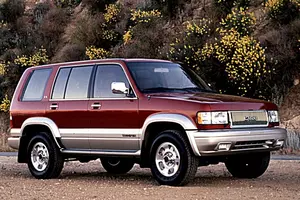
| Vehicle | Precise engine size | Difference from world average | Engine size to consumption ratio | Horsepower from 1 L | Engine size to 100 kg of weight |
|---|---|---|---|---|---|
| 3.1 DT |
3.06 L (3059 cc) |
30.4% bigger | - | 41 hp from 1 L | 153 cc to 100 kg |
| 3.5 i V6 |
3.49 L (3494 cc) |
48.9% bigger | - | 67 hp from 1 L | 175 cc to 100 kg |
| 3.2 i V6 |
3.17 L (3165 cc) |
34.9% bigger | - | 63 hp from 1 L | 158 cc to 100 kg |
| 3.0 DT |
3 L (2999 cc) |
27.8% bigger | - | 53 hp from 1 L | 143 cc to 100 kg |
| 2.2 D |
2.24 L (2238 cc) |
4.6% smaller | - | 39 hp from 1 L | 132 cc to 100 kg |
| 2.6 i S |
2.56 L (2559 cc) |
9.1% bigger | - | 47 hp from 1 L | 151 cc to 100 kg |
| 2.8 DT |
2.77 L (2771 cc) |
18.1% bigger | - | 42 hp from 1 L | 163 cc to 100 kg |
| Vehicle | 3.1 DT |
|---|---|
| Precise engine size | 3.06 L (3059 cc) |
| Difference from world average | 30.4 bigger |
| Engine size to consumption ratio | - |
| Horsepower from 1 L | 41 hp from 1 L |
| Engine size to 100 kg of weight | 153 cc to 100 kg |
| Vehicle | 3.5 i V6 |
| Precise engine size | 3.49 L (3494 cc) |
| Difference from world average | 48.9 bigger |
| Engine size to consumption ratio | - |
| Horsepower from 1 L | 67 hp from 1 L |
| Engine size to 100 kg of weight | 175 cc to 100 kg |
| Vehicle | 3.2 i V6 |
| Precise engine size | 3.17 L (3165 cc) |
| Difference from world average | 34.9 bigger |
| Engine size to consumption ratio | - |
| Horsepower from 1 L | 63 hp from 1 L |
| Engine size to 100 kg of weight | 158 cc to 100 kg |
| Vehicle | 3.0 DT |
| Precise engine size | 3 L (2999 cc) |
| Difference from world average | 27.8 bigger |
| Engine size to consumption ratio | - |
| Horsepower from 1 L | 53 hp from 1 L |
| Engine size to 100 kg of weight | 143 cc to 100 kg |
| Vehicle | 2.2 D |
| Precise engine size | 2.24 L (2238 cc) |
| Difference from world average | 4.6 smaller |
| Engine size to consumption ratio | - |
| Horsepower from 1 L | 39 hp from 1 L |
| Engine size to 100 kg of weight | 132 cc to 100 kg |
| Vehicle | 2.6 i S |
| Precise engine size | 2.56 L (2559 cc) |
| Difference from world average | 9.1 bigger |
| Engine size to consumption ratio | - |
| Horsepower from 1 L | 47 hp from 1 L |
| Engine size to 100 kg of weight | 151 cc to 100 kg |
| Vehicle | 2.8 DT |
| Precise engine size | 2.77 L (2771 cc) |
| Difference from world average | 18.1 bigger |
| Engine size to consumption ratio | - |
| Horsepower from 1 L | 42 hp from 1 L |
| Engine size to 100 kg of weight | 163 cc to 100 kg |

| Vehicle | Precise engine size | Difference from world average | Engine size to consumption ratio | Horsepower from 1 L | Engine size to 100 kg of weight |
|---|---|---|---|---|---|
| 2.2 D |
2.24 L (2238 cc) |
4.6% smaller | - | 39 hp from 1 L | 140 cc to 100 kg |
| Vehicle | 2.2 D |
|---|---|
| Precise engine size | 2.24 L (2238 cc) |
| Difference from world average | 4.6 smaller |
| Engine size to consumption ratio | - |
| Horsepower from 1 L | 39 hp from 1 L |
| Engine size to 100 kg of weight | 140 cc to 100 kg |